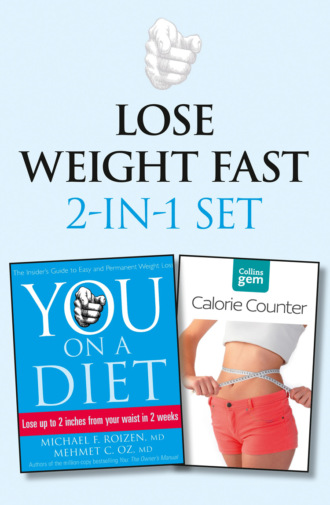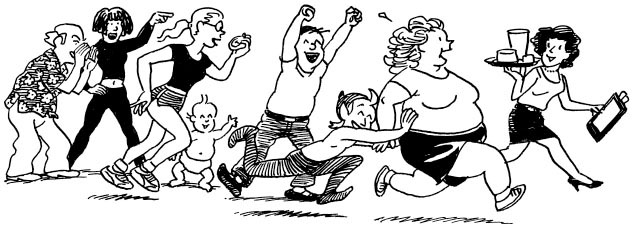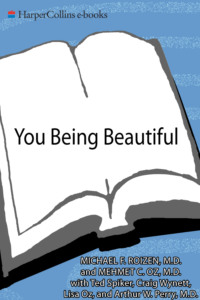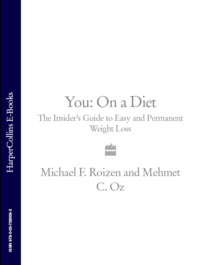
Полная версия
You: On a Diet plus Collins GEM Calorie Counter Set
You have to stop thinking that this game is you versus a stadium full of rib-loving opponents. Sure, you need to be the quarterback of your waist control team, but you won’t achieve success without a team that can block for you, high-five you when you’re doing well, and give you an encouraging smack on the butt when you’re not. Your starting lineup should include your doctor, maybe a nutritionist, maybe a personal trainer, and certainly scads and scads of fans like your family and friends (online or in person) who can push you, support you, and yank the bowl of candy corn away from you. But you shouldn’t be the only one relying on other people; you should use this opportunity to find a support partner who needs you as much as you need her. After all, the best kinds of satisfaction shouldn’t come from the sixth spoonful of cake batter, but from sharing knowledge and support, and helping others lose inches.

YOU Will Stop Blaming Yourself
The classic psychology of fat is this: If you’re thin, then you believe that fat people must be doing something wrong to make them fat. But if you’re fat, then you blame the environment, or your genetics, or anything else. Well, we’re going to try to eliminate that blame and use medical insights to explain the epic saga of weight-related problems. We want to move dieting past a guilt-driven and blame-ridden system, and make it a science-based system.
Of course, not everyone can look like a Cameron Diaz or a Brad Pitt. To get an idea of what your healthy weight, waist, and shape should be, you’ll need to take into account such things as bone structure, muscle mass, genetics, and risk factors associated with your weight. Here’s a fact that goes virtually unmentioned: There are clinically obese people who live with no risk of health problems, and there are CD-thin people whose risk of dying prematurely is more than a chuteless sky-diver’s. Our goal is to get you to the point where you strip away inches, you strip away the risks of being overweight, and you strip away the guilt associated with the process of always trying to do so.
YOU Will Never Be Hungry
We know exactly how you’ve felt when you’ve dieted in the past. Hungry. Famished. Three seconds away from steamrolling through a triple-dip cone with sprinkles. That recipe for dieting is one you can tear up. In fact, the only place hunger ever got you was a pair of pants that could double as curtains. To eat and work smart, your goal is never to be hungry and never to be in a state of dietary angst, where your only salvation is the 99¢ menu at the drive-through window. By keeping your hunger (and internal chemicals) in check, you’ll avoid the impetuous behaviors that send fat on an express ride to your belly.
YOU Will Make Mistakes
Look, we don’t care how motivated you are, how willing you are, how inspired you are by Eva Longoria’s body. Someday, and someday soon, a volleyball-size muffin is going to get the best of you and nudge, bribe, or cajole its way into your stomach. That’s OK. Hear that? That’s OK. You’re going to have moments when your eyes, body, and curious fingers won’t be able to turn radar lock off of the queso dip. You have to get past the concept that diets have side effects—that is, unexpected negative consequences. Instead, realize that eating plans have effects—offshoot actions, behaviors, and emotions that are simply part of everyday living. One of those effects is that you will occasionally eat things that are nutritional cigarettes; while one may not hurt you, it can get you addicted to some bad behaviors. Because of that, waist management is about developing contingency plans—plans that allow you to make mistakes and then get back on the right road. We’re going to teach you how to make a YOU-Turn when you do make mistakes with Twinkies or Tootsie Rolls or any bad-for-your-waist foods. That way, your dietary fender benders won’t turn into 100-car Autobahn pileups.

YOU Will Be Flexible—and Have Fun
Most of us want our diets to be a little like having the remote control; we want the power to make lots of choices, depending on everything from our mood to the time of day. It’s clear from research that the most successful eating plans are low-maintenance: You can follow them with your family, and you won’t feel overwhelmed by cravings. If you can do that, you’ll get results. But try to stay on a diet where you feel more isolated than a Yankees fan at Fenway Park, then chances are that the result will feel like the box-office numbers of a B-level horror flick—a miserable failure.
Eating right shouldn’t be about feeling bad. It should be about feeling strong, increasing energy, living better, feeling healthier, and having more fun than a front-row rock fan. It should be about eating without thinking and without obsessing about every forkful. Of course, we all have reasons for overeating or eating the wrong kinds of food (stress, boredom, comfort, five-cent wing specials). But our goal isn’t just for you to make by-the-book food substitutions or come to grips with your Devil Dog demons. You should be grinning—not grimacing, grunting, and growling—as the inches melt away from your waist, and laughing as your lipid profile improves. You’ll understand how, after we show you how the mind-stomach connection works by explaining how brain and belly chemicals control what the mind thinks, how the fork acts in your bodily orchestra, and how this relationship can become a cacophony in the wrong hands.
So now that we’re about to begin, you’re probably asking, What are we going to do, and how are we going to do it? Well, we’re going to give you everything you need to make a body change—through a series of elegant and effective changes based on hard science—that will stick with you for your life. Simply, this book will serve as your lifelong waist management, body-changing plan.
Best of all, when you put it all together and integrate automatic actions into your life, you’ll live by the principles you’ll need to stay fit and healthy, so that you can achieve and maintain exactly what you’re striving for:
Your ideal body.
The Fat Facts Test

What Do You Really Know about Fat, Diets, and Other Weight-loss Solutions?
To help you determine your level of dietary knowledge, take this Fat Facts Test. In less time than it takes to listen to an American Idol off-key clunker, you may just learn more about your body and belly than you’ve ever known before.
1 What is the first historical event that we can point to as contributing to the rise in excess pounds?The development of agriculture.The development of whipped cream in coffee.The development of more office jobs.The development of fast food.
2 What is the reason most diets fail?They’re designed so that they’re impossible to stick to long-term.They’re so complicated that you need a math degree to follow them.There are only so many carrot sticks and celery stalks a person can take.Mozzarella sticks. Mmm!
3 Which of the following strategies is most recommended for people trying to lose weight?Weighing yourself once a week.Eating two to three small meals a day.Eating nuts every day.Ex-Lax smoothies for everyone!
4 What’s the most important number for determining whether an increased waist size is putting you at risk for health problems?Bra size.Blood pressure.Cholesterol.Heart rate.
5 What is ghrelin?The name of a Harry Potter character.A hormone that makes you want to eat more.The name of fat cells in your belly.The chemical in your brain that makes you feel good.
6 What is leptin?The name of the dude on the Lucky Charms cereal box.The muscle-building protein that helps burn fat.The nutrient in fruit that works in conjunction with fiber.A chemical from fat that tells your brain you are full.
7 Which spice has been shown to be helpful for controlling weight?Cinnamon.Thyme.Oregano.The one married to David Beckham; Posh, is it?
8 Complete this sentence with the most accurate response. Fructose .Is responsible for decreasing the number of calories in many foods.Tricks your mind so you stay hungry longer.Is responsible for increasing the amount of bad-for-you trans fat in foods.Sure makes my Trix taste darn good.
9 What does your body most want to do in periods of extreme stress?Stay away from food.Gorge on food.Seek crunchy foods.Crumple up into a pile of jelly and retreat to a warm bath.
10 Which choice is most recommended to cut your appetite?Whole-grain foods.Whole aisles of fruit.Whole lot of a diet soda.Whole boxes of Girl Scout cookies.
11 Of the following choices, which is least dangerous to a long-term waist management strategy?A 1,000-calorie-a-day diet.Higher than usual colonics ro remove all fat.Training for a marathon.Playing video games.
12 Which organ is most responsible for metabolism?Heart.Stomach.Liver.Kidneys.
13 Which condition is responsible for weight gain in about 10 to 20 percent of younger women?Vulvodynia.Hyperthyroidism.Polycystic Ovary Syndrome (PCOS).I’ve had six kids, so cut me a break, would ya?
14 Calorie for calorie, what fills you up for the longest amount of time?Fat.Fiber.Fructose.French fries.
15 At least how much must you walk daily for optimum waist control?Thirty minutes.Two hours.Any time you can spare.Any, as long as it’s not traveling to and from the fridge.
16 What is the main purpose of liposuction?To help people lose weight.To target problem body parts.To keep some Hollywood docs in business.To ensure another season of successful reality TV.
17 What is your omentum?A badly misspelled word.The part of your brain that’s stimulated to store fat.A chemical that controls hunger.A fat-storing tissue.
18 Health-wise, what is the optimal waist size for a woman?As little as possible.32½ inches.Under 35 inches.Whatever slides into that little black dress, honey.
19 Which part of your body that plays a role in weight gain works most like your brain?Your stomach.Your heart.Your small intestine.Your unmentionables.
20 What is CCK?The former Soviet Union.A hormone that regulates insulin levels by changing your blood sugar level.Colonic Creations by Katherine.Cholecystokinin, a chemical that tells your brain to stop eating the waffle.
21 Of the following items, what contributes most to weight gain?Periods of low levels of willpower.Short periods of high-intensity stress.Long periods of low-intensity stress.Periods of high-intensity dessert trays.
22 What is a duodenal switch?An effective surgical technique for losing weight.An intestinal transplant.The hot new band from Seattle.A program for cleansing your colon of toxins.
23 Which of the following can be an effective medical option for weight loss?Aspirin.Beta-blockers.Statins.Antidepressants.
24 Which activity is most helpful for waist control?Crunches.Cardiovascular training like running.Resistance training like weight lifting.Naked salsa dancing every other Tuesday.
25 What’s the worst side effect of losing weight?Increased risk of chocolate withdrawal.Increased risk of muscular and joint aches.Increased risk of yo-yo dieting.Increased risk of astronomical tailor bill.
Answers
1 a. The development of agriculture meant that we could now have foods we wanted, not needed. And that’s what provided the foundation for indulgence.
2 a. Most diets don’t reprogram you to think and eat automatically, so that eventually you’ll go off the diet just as surely as you went on it.
3 c. Eating a handful of nuts has been shown to help you stay full, while skipping meals can be detrimental because your body will go into a fat-storing, starvation mode when it doesn’t have enough calories.
4 b. Of these risks, blood pressure is the greatest indicator of health risks associated with being overweight.
5 b. Ghrelin makes you want to eat more.
6 d. Leptin keeps you full.
7 a. Cinnamon increases insulin sensitivity, which helps enhance the satiety center in your brain (and also reduces blood sugar levels as well as cholesterol levels).
8 b. Fructose, as in high-fructose corn syrup, doesn’t appear to turn off your hunger chemicals, so you do not feel full; thus you eat more.
9 a. Extreme stress (as in the case of a car accident, or even exercise) turns off your hunger. Chronic stress (like a long line of looming deadlines or family problems) can make you crave feel-good carbohydrates.
10 a. Whole-grain foods are loaded with filling fiber.
11 d. Playing video games works because it keeps your hands busy, so you can’t eat. (Training for a marathon is actually destructive to your body because of the risk to your joints, and for most people, 1,000 calories is a dangerously low daily caloric intake. Do we really need to explain colonics?)
12 c. Your liver is responsible for most metabolic functions.
13 c. PCOS is responsible for weight gain in at least 10 percent of women under age fifty. It’s now clinically called androgen excess; androgen refers to the male hormone.
14 b. Fiber fills you. A cup of oatmeal in the morning has been shown to prevent you from afternoon gorging.
15 a. Walk at least thirty minutes-at once or in intervals-every day.
16 b. Liposuction should be used to sculpt problem areas, not to remove a lot of fat.
17 d. Located next to your stomach, your omentum is fat that can cause damage to surrounding organs.
18 b. While 32½ inches or less is ideal, 37 inches is when women start seeing a greatly increased risk of weight-related disorders.
19 c. Your small intestine-with 100 million neurons-has anatomy similar to your brain.
20 d. CCK is a chemical that directly and indirectly sends a message to your brain from your guts that you’re full.
21 c. Chronic stress makes your body store more fat.
22 a. A duodenal switch is one of several surgical options for people with morbid obesity.
23 d. Bupropion, an antidepressant, has been shown to help control cravings and lead to about a 7 percent weight loss. Other antidepressants, such as tricyclic antidepressants or selective serotonin reuptake inhibitors (SSRIs), can often be associated with weight gain.
24 c. Adding a little muscle through resistance training helps your body burn more fat throughout the day.
25 c. Yo-yo dieting not only has physiological effects, because you end up gaining more weight after you’ve lost it, but it also has psychological effects.
Scoring
You get one point for each correct answer.
20 and above: Congratulations, doc. You’re an anatomical expert.
11–19: You’re average, but then again, the average person is overweight, so maybe this isn’t so good. Maybe you’d better read on.
10 and below: Don’t worry, you’re about to enroll in the ultimate course in the biology, history, and anatomy of fat-which is the best way to change your body.
Chapter 1
The Ideal Body
What Your Body Is Supposed to Look Like
Diet Myths
Your body doesn’t need any fat.
Fast food is responsible for most of our fat problems.
Dieting has to be hard.
The most common question heard among overweight people isn’t “Can I have more sour cream?” It’s “Why can’t I lose weight?” While you may think you know the answer (severe pancake addiction), the real reason is biological: We’re actually hardwired to store some fat.

Our bodies have more systems that allow us to gain weight than to lose it. Historically, as we’ll see in a moment, that served us well. Today, though, we’ve poisoned the systems that help us lose weight and empowered the ones that allow us to gain it—botching up our anatomy and turning our bodies into fat-storing machines. One of your goals will be to reprogram your body so that your internal systems can work the way they did when the greatest enemy we faced was a charging wildebeest, not a cheese-drowned pork roll.
Our ancestors survived by gaining and storing weight to survive periodic famines. That has left our bodies prone to storing fat and gaining weight, tendencies that willpower alone can rarely overcome. To see how our bodies have morphed from rock-hard to sponge-soft, let’s look inside the bodies of early man and woman. They looked like stereotypical super-heroes: strong, lean, muscular, able to jump snorting mammals in a single bound.

As we evolved, we created systems and behaviors to survive when droughts and poor eyesight made picking and hunting less than successful. We learned to thrive, and we learned to eat. In early times, our diets consisted of fruits, nuts, vegetables, tubers, and wild meat—foods that were, for the most part, low in calories. That’s not to say our ancestors didn’t enjoy their foods. They consumed their sugars through fruit, and they even splurged when they came across the Paleolithic Cinnabon—a honeycomb. The difference between their splurges and ours? They came across the sweet treats only rarely; it’s not as if they popped in for a 900-calorie sugar bomb every time they went shopping for a new buffalo hide. Add that to the fact that their definition of “searching for food” included walking, stalking, and chasing, not sliding the milk carton out of the way to find the pudding pack. It was a lot of work to get food, so they naturally burned many of the calories they consumed through the physical activity of hunting and gathering.
The Heavyweight Fight: Genetics Versus Environment
It’s easy to argue that lifestyle choices and lack of willpower are responsible for weight problems (it’s the argument that lean people tend to make). But it doesn’t explain the 95 percent failure rate after two years of people who have lost fifty pounds or more; they had plenty of willpower to lose but regained the weight nonetheless. Researchers argue that obesity is more genetically linked than any other trait except height-and at least 50 percent of obesity cases clearly have genetic components. Our take: The waist control game requires two players-environment and genetics. Even if your genes have made you predestined for a life of taking up two seats, that doesn’t mean you should abdicate control over your body. When you make the right behavioral and biological changes that we outline, you’ll be able to stay healthy and avoid the bad side effects of excess weight, like diabetes, high blood pressure (hypertension), and arterial inflammation. While 10 percent of the obese population has genetic challenges that may make a supermodel contract impossible, the bigger risk with these genes is not in the weight itself but in the predispositions for risks associated with obesity. For example, one genetic problem associated with being overweight is called leptin deficiency (leptin is a hormone associated with satiety, which we’ll discuss in the next chapter). Folks who either don’t produce leptin or block its signals usually become morbidly obese, and the problem is surely genetic.
While some people have these abnormalities, they tend to be the minority of the population. If you need to worry about losing twenty-five, thirty-five, even fifty pounds, your problem is not likely to be genetic. Only when your excess weight exceeds one hundred pounds would most doctors consider testing for genetic abnormalities. Still, the example of leptin is only the tip of the scientific iceberg as far as genetics and obesity are concerned. As the fight against obesity continues, we’ll see more and more drug companies target genetic reasons for weight gain-that is, drugs that attack the genetic biochemical problems that may be contributing to your weight problem. That said, the onus of waist management still falls on you, to improve your environment and your behaviors so that your genetics can work for you, not against you.
Because salt and sugar were scarce, our ancestors mostly feasted on grains, vegetables, and meats—for good reason. The meat provided the protein, vitamins, minerals, and fatty acids that helped them grow taller and develop larger brains, while the other foods gave them nutrients such as glucose, a simple sugar found in fruit and the complex carbohydrates of plants, that they needed to grow and develop, and for energy to move. And, of course, food was always fresh, as there was no canning or refrigeration to store up food for Super Bowl parties, or to sneak in an 11 p.m. bowl of sugar-coated oats.
FACTOID
The difference between obese people and thin people isn’t the number of fat cells, it’s the size of these cells. You don’t make more fat cells the fatter you get; you have the same number of fat cells you had as an adolescent. The only difference is that the fat globules within each cell increase as you store more fat. By the way, muscles work the same way: you don’t make more muscle cells; the muscle cells get larger.
Another difference was that the meat our ancestors ate wasn’t like the meat we know today. Theirs was low in fat and high in protein; ours often comes in the form of corn-fed cows pumped up to make fattier, tastier cuts. Even today’s buffalo burger is corn-fed. Truly wild game has about 4 percent fat, while now most commercially available beef has nine times that amount. (The theory behind protein-heavy diets like Atkins is that protein reduces overall food intake and could reduce calories as well. The flaw is that eating proteins dripping in saturated fat, like bacon, isn’t exactly the same as eating the leaner, healthier forms of protein like chicken and fish.)
The result: Your tribal forefathers and foremothers could eat anytime they could harvest or catch something, and still not put on excess weight.
The lesson: Our ancestors never thought about a diet in the way we do—and their bodies had the approximate density of granite. Us? We obsess about diet more than red-carpet reporters obsess about designer dresses, and our bodies have the consistency of yogurt.
Still, we can’t blame the advent of fast food and waffle cones for all of our weight issues. The downfall started in the pre-GA. (pre-Golden Arches) era—over 10,000 years or so ago, when agriculture first appeared. Agriculture allowed us to make more advances than a seventeen-year-old boy in a movie theater, but we paid a price for them. Besides Myth Buster sparing the lives of countless mammoths, the rise of agriculture ensured that we’d always have a steady supply of food—an advantage during times of famine, a disadvantage at the $6.99 Mama’s Kitchen Eat-Everything Buffet. With a constant source of food, people became less nomadic, and communities grew closer together. While the average life span increased (thanks to the elimination of the extreme sport of tiger chasing, with, perhaps, some help from sanitation and immunization), agriculture also brought its share of downsides: more bacterial infections, shorter stature, and rotting teeth that comes from eating refined sugar and less nutritious farm-raised food (overused soil depletes food of its nutrients). Our ancestors’ diets shifted from vegetables and meat to grains from the farms, essentially hindering them from getting the diverse mix of protein and micronutrients needed for brain development.

FACTOID
During the Muslim holiday of Ramadan, people eat only after sunset so they consume all their calories at night. Should they lose weight? Anecdotal evidence, gathered by doctors watching residents working all-night shifts, indicates that people who eat all their 2,000 daily calories in one meal gain more weight than those who space those calories over three meals. Why? Because the one-timers are kicking in their starvation mode, making their bodies want to store fat rather than burn it.





